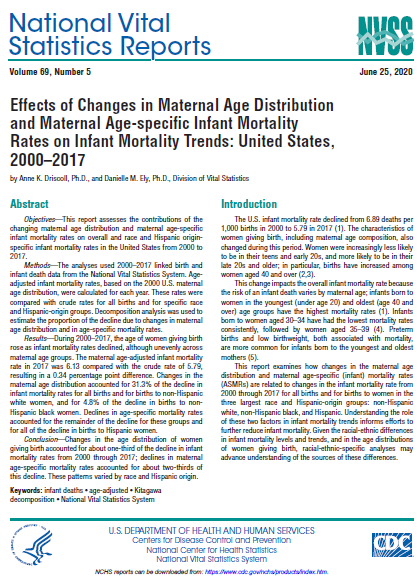Effects of Changes in Maternal Age Distribution and Maternal Age-specific Infant Mortality Rates on Infant Mortality Trends: United States, 2000–2017
Posted on by Questions for Anne Driscoll, Health Statistician and Lead Author of “Effects of Changes in Maternal Age Distribution and Maternal Age-specific Infant Mortality Rates on Infant Mortality Trends: United States, 2000–2017.”
Questions for Anne Driscoll, Health Statistician and Lead Author of “Effects of Changes in Maternal Age Distribution and Maternal Age-specific Infant Mortality Rates on Infant Mortality Trends: United States, 2000–2017.”
Q: What is difference between maternal age distribution and maternal age-specific infant mortality rates?
AD: “Maternal age distribution” refers to the percentage of women with a birth in each maternal age category; for example, the percentage who are 15-19 years old, the percentage who are 20-24 years old. The “maternal age-specific infant mortality rate” is the mortality rate of infants born to women in a given maternal age category; for example, the mortality rate of infants born to women who were 20-24 years old.
Q: Was there a specific finding in the data that surprised you from this report?
AD: It was somewhat surprising that changes in maternal age distribution mattered little or not at all for the mortality trends for infants born to non-Hispanic black and Hispanic women given the significant changes in the maternal age distribution for both groups during the study period.
Q: How did you obtain this data for this report?
AD: The data are from the National Vital Statistics System (NVSS); we used natality data sets and infant mortality data sets from 2000-2017. Natality data sets are comprised of information from all birth certificates in a given year; infant mortality data sets are comprised of information from all death certificates to persons under one year of age in a given year.
Q: What is the take home message for this report?
AD: Changes in the age distribution of women giving birth accounted for about one-third of the decline in infant mortality rates from 2000 through 2017 while declines in maternal age-specific mortality rates accounted for about two-thirds of this decline. However, these patterns varied markedly by race and Hispanic origin.
Posted on by

